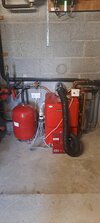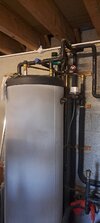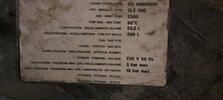As I said before you can get the 26/46 to run on a .75 nozzle you would also require a air restriction plate in burner Grant will supply this f o c.In view of the fact that there is 26/46kw stamped on your boiler you might ask Grant what is the actual lowest boiler output achievable, otherwise you just have to live with the 36kw when you change the nozzle.
You are using an out of date browser. It may not display this or other websites correctly.
You should upgrade or use an alternative browser.
You should upgrade or use an alternative browser.
UFH condensing oil boiler short cycling
- Thread starter markmorrison1957
- Start date
Sponsored Links
- Joined
- 6 Oct 2024
- Messages
- 45
- Reaction score
- 0
- Country

I think with all the very helpful advice for which I am extremly grateful, I have exhausted most of all the various permutations regarding boiler temperature and both pumps speed settings.
Really there has been little difference but - we tried.
Thank you Johntheo5 re all your comments and advice on contacting Grant re lowest possible nozzle size and thanks Exedon that indeed the burner is 26-46 maybe a .75 nozzle with adaption is possible.
I'll arrange the installer to return next week!
Of course I will update this thread with actions and results so anybody in similar circumstances may not need to tear their hair out in short cycling frustration.
Thanks all for now.
Really there has been little difference but - we tried.
Thank you Johntheo5 re all your comments and advice on contacting Grant re lowest possible nozzle size and thanks Exedon that indeed the burner is 26-46 maybe a .75 nozzle with adaption is possible.
I'll arrange the installer to return next week!
Of course I will update this thread with actions and results so anybody in similar circumstances may not need to tear their hair out in short cycling frustration.
Thanks all for now.
I'm hoping that your boiler was installed by an OFTEC registered engineer and has been properly commissioned. If so give OFTEC a ring. They should be able to get an inspector out to check the installation. They can force the engineer to remove the boiler and fit the correctly sized boiler, or to get grants permission to fit a smaller output burner.
to reduce the burner output from the factory size of 41kw with the 1.1/60/es nozzle you need to fit an air adjuster disc (( part number Z20094349) although this was supplied with the boiler) and then you can fit a 0.75/60/es which will drop power down to 26kw. Any competent oil engineer though should be able to set it with the disc and use postion A and then should be able to use 0.6/60/es and drop the output down to 21kw.
otherwise you could purchase a brand new rdb2.2bx v15/26 which you can drop down to 15kw which will fit your boiler. they are about £375
to reduce the burner output from the factory size of 41kw with the 1.1/60/es nozzle you need to fit an air adjuster disc (( part number Z20094349) although this was supplied with the boiler) and then you can fit a 0.75/60/es which will drop power down to 26kw. Any competent oil engineer though should be able to set it with the disc and use postion A and then should be able to use 0.6/60/es and drop the output down to 21kw.
otherwise you could purchase a brand new rdb2.2bx v15/26 which you can drop down to 15kw which will fit your boiler. they are about £375
- Joined
- 6 Oct 2024
- Messages
- 45
- Reaction score
- 0
- Country

Hi Snb1. Thank you for your very helpful thread. The installing engineer is indeed OFTEC registered. Grant have already confirmed a smaller nozzle can be installed and if there is little or no difference to the short cycling to get back in touch with them and they will advise on next steps. I think the engineer would probably prefer to reduce nozzle size as a first and subsequent step rather than remove and replace boiler. It's good to know that a brand new smaller RDB 2.2bx 15/26 burner will fit as the cost would be similar to fitting a buffer tank - and I don't know what size of buffer would be needed to "size it correctly". Johntheo5 mentioning in previous thread about a shorter blast tube and I will mention to Grant technical help is that required. Atm a smaller nozzle is next step! I think it's best to go down size by size to check that both ufh and radiators aren't compromised! As a bye the way a smaller nozzle/s should give a marked reduction in oil consumption of 5000L annually!
Sponsored Links
5000lt a year is a lot even if short cycling. That’s around 50000kw/yr. with that being the amount dropping output down to 26kw should be small enough to heavily reduce the cycling.
Yes a 100lt buffer tank would also help reduce cycling.
Yes a 100lt buffer tank would also help reduce cycling.
I poked out a old spreadsheet I made out a few years for someone who was very keen to install a buffer on a oil fired boiler and rejigged it to reflect (I hope) three Grant outputs, 41kw, 36kw & 26kw and the results are quite interesting.
I configured it so that the minimum boiler minimum run time is 1 min but input whatever suits yourselves.
If one is happy with very short burn times, which I am, I have a 19 year old SE Firebird that often fires for 1 min or so but has not cost a single cent in repairs, I would venture that there are thousands of other similar oil fired boilers that operate perfectly in the same manner. If one accepts this view then it is impossible to "justify" any reason to install a external buffer but I've included a buffer calc as well, once the cycle time is 2 min or greater then IMO it will actually cost more to run with a buffer as the boiler return temps will be higher and outside the condensing range, with UFH especially running with return temps of say 45C (boiler only) will result in a nice efficiency gain due to the condensing effect. Anyway have a look at the attached.
I configured it so that the minimum boiler minimum run time is 1 min but input whatever suits yourselves.
If one is happy with very short burn times, which I am, I have a 19 year old SE Firebird that often fires for 1 min or so but has not cost a single cent in repairs, I would venture that there are thousands of other similar oil fired boilers that operate perfectly in the same manner. If one accepts this view then it is impossible to "justify" any reason to install a external buffer but I've included a buffer calc as well, once the cycle time is 2 min or greater then IMO it will actually cost more to run with a buffer as the boiler return temps will be higher and outside the condensing range, with UFH especially running with return temps of say 45C (boiler only) will result in a nice efficiency gain due to the condensing effect. Anyway have a look at the attached.
Attachments
Can you take a few readings sometime with just the HW cylinder being heated as I feel that will br your lowest heat demand especially when the cylinder is almost up to temp, just a few on/off burner times and the wilo power.Hi Snb1. Thank you for your very helpful thread. The installing engineer is indeed OFTEC registered. Grant have already confirmed a smaller nozzle can be installed and if there is little or no difference to the short cycling to get back in touch with them and they will advise on next steps. I think the engineer would probably prefer to reduce nozzle size as a first and subsequent step rather than remove and replace boiler. It's good to know that a brand new smaller RDB 2.2bx 15/26 burner will fit as the cost would be similar to fitting a buffer tank - and I don't know what size of buffer would be needed to "size it correctly". Johntheo5 mentioning in previous thread about a shorter blast tube and I will mention to Grant technical help is that required. Atm a smaller nozzle is next step! I think it's best to go down size by size to check that both ufh and radiators aren't compromised! As a bye the way a smaller nozzle/s should give a marked reduction in oil consumption of 5000L annually!
- Joined
- 6 Oct 2024
- Messages
- 45
- Reaction score
- 0
- Country

Okey doke - not at home atm but later
- Joined
- 6 Oct 2024
- Messages
- 45
- Reaction score
- 0
- Country

Johntheo5 - it's a very interesting spreadsheet (Im keen on spreadsheets) and supports the advice from snb1 regarding downsizing nozzles sizes. It's good to have calculations that show a buffer tank shows little or no reduction in average burner run irregardless of nozzle size therefore of no benefit by itself. Would dropping down to 36 or 26kw with say a 50L buffer tank show significantly less run time?
I took timings this afternoon running just hw cylinder. The boiler was off for 8m 30s but then somebody in the house turned on a tap and it fired up for 50 seconds - I don't know if the action of turning on a tap caused it to fire up so will do more timings. The wilo pump on setting 2 showed 75w. I have to mention the hot water is on a loop system with a pump on the hw cylinder giving an almost instant supply of hot water when demanded!
I took timings this afternoon running just hw cylinder. The boiler was off for 8m 30s but then somebody in the house turned on a tap and it fired up for 50 seconds - I don't know if the action of turning on a tap caused it to fire up so will do more timings. The wilo pump on setting 2 showed 75w. I have to mention the hot water is on a loop system with a pump on the hw cylinder giving an almost instant supply of hot water when demanded!
Johntheo5 - it's a very interesting spreadsheet (Im keen on spreadsheets) and supports the advice from snb1 regarding downsizing nozzles sizes. It's good to have calculations that show a buffer tank shows little or no reduction in average burner run irregardless of nozzle size therefore of no benefit by itself. Would dropping down to 36 or 26kw with say a 50L buffer tank show significantly less run time?
I took timings this afternoon running just hw cylinder. The boiler was off for 8m 30s but then somebody in the house turned on a tap and it fired up for 50 seconds - I don't know if the action of turning on a tap caused it to fire up so will do more timings. The wilo pump on setting 2 showed 75w. I have to mention the hot water is on a loop system with a pump on the hw cylinder giving an almost instant supply of hot water when demanded!
That test would only seem to indicate a cylcoil/boiler demand of 2 to 3kw, but the on/off times (with a 41kw nozzle) don't marry up to yours so a repeat test would be good, can then rerun the numbers. What is the size/make/model of the HW cylinder?, unvented/vented?.
That test would only seem to indicate a cylcoil/boiler demand of 2 to 3kw, but the on/off times (with a 41kw nozzle) don't marry up to yours so a repeat test would be good, can then rerun the numbers. What is the size/make/model of the HW cylinder?, unvented/vented?.
Just ran the numbers again before heading for the bunk, assumed a 3kw demand and a 50L buffer.
Attachments
That means the circulation flow through the cylinder coil is 53.3LPM (@ 3.2M), seems extremely high which means a 0.81C coil dT (IF the coil output is only 3.0kw ish) and a boiler return of ~ 60C, You shoud look for a automatic bypass valve, ABV, somewhere and check its settings.The wilo pump on setting 2 showed 75w. I have to mention the hot water is on a loop system with a pump on the hw cylinder giving an almost instant supply of hot water when demanded!
The reason for instant HW is because you will have a secondary (bronze) pump circulating HW around your sysyem, the control for this should also be checked out as you may be wasting energy, it should be disabled during the day because of the massive vol of HW you are using daily when all the pipwwork will be hot anyway.
- Joined
- 6 Oct 2024
- Messages
- 45
- Reaction score
- 0
- Country

I've been looking all over the pipework but cannot see an abv! The blue valve at top of 200L hw cylinder just seems to be hot water circuit but no direct connection between flow and return! Still to do timings for hw.
Attachments
- Joined
- 6 Oct 2024
- Messages
- 45
- Reaction score
- 0
- Country

DIYnot Local
Staff member
If you need to find a tradesperson to get your job done, please try our local search below, or if you are doing it yourself you can find suppliers local to you.
Select the supplier or trade you require, enter your location to begin your search.
Please select a service and enter a location to continue...
Are you a trade or supplier? You can create your listing free at DIYnot Local
Sponsored Links
Similar threads
- Replies
- 0
- Views
- 2K
- Replies
- 8
- Views
- 4K
- Replies
- 6
- Views
- 2K
- Replies
- 57
- Views
- 17K
G



